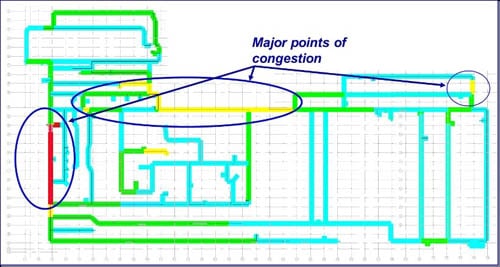 What Are Material Flow Systems in Manufacturing?
What Are Material Flow Systems in Manufacturing?
Manufacturing material flow is the movement of components, raw materials, and other inventory through the processing cycle to create a finished product and deliver it to the consumer.
Material flow is arguably the most important function in a manufacturing company because it addresses the process of creating products from materials, and those products and their sale are necessary for the financial viability of the company.
Benefits of Material Flow Optimization and Analysis
Efficiency in material flow results in increased profits. By having a lean manufacturing consulting company conduct a material flow analysis (MFA) in manufacturing, a company can save on capital investments and significantly reduce costs for storing, transporting and handling. In addition, energy usage and waste is reduced and required floor space is minimized, decreasing overall production time and allowing more efficient allocation of resources and work hours.
Looking ahead to the long term, smooth material flow systems allow for sustainable production. It enables compliance with rigorous future requirements for transparency and sustainability, reduction of the company’s carbon footprint and efficient utilization of raw materials.
What Is Engineered Material Flow?
The optimal design of material flow systems in manufacturing allows for dynamic processing that can be tweaked to account for changes in product volume, quantity and type. It’s also interactive, working and communicating with human and other system data and processes. In addition, it’s predictable, functioning as planned with smooth resolution to any issues that may occur. Engineering an optimal flow allows manufacturers to reduce waste and increase production capabilities according to three connected principles:
- Planning: Engineered material flow requires a specific and intentional outline of the movement of material, including accurate data on components and materials and identification of every step of the manufacturing process.
- Communication: Seamless operation requires communication and signals. Signals can take many forms, including arrows on the floor, overhead lighting, barcodes, colored boxes and numbered signs.
- Tools: The choice of tools depends on the manufacturing environment. Processes should be examined first and equipment should then be chosen to fit the needs.
Stages of Optimized Material Flow
Creating an optimized material flow to facilitate efficiency in the manufacturing workplace is a huge task. These four stages of optimization enable an easier transformation:
- Collect data: In many organizations, the departments operate separately, creating siloed data and a potential for errors due to lack of communication. Fix this by enabling access to data from beginning to end of the production process and collection in a central location.
- Automate process monitoring: Automated programs that detect deviations in processes ensure the material flow is uninterrupted.
- Visualize current data: Use of technology gives operators and managers relevant and timely views of the material flow, allowing them to complete their jobs efficiently.
- Predict and act: Machine learning and predictive analytics enable technology to identify glitches and anticipate issues like bottlenecks or overflows, allowing employees to act quickly and prevent stoppage.
Cost Benefits From Optimized Material Flow
Industrial engineering companies such as DSI. can help you realize cost savings through improvements to manufacturing material flow in the following ways:
- Planning for every part: Following the material flow analysis in manufacturing, a database should be created that contains critical information about all manufacturing parts, leading to controlled inventory reduction and a continuous improvement process.
- Dock utilization: A survey of dock usage can determine whether the current configuration and number of docks is sufficient or if the setup needs rebalancing to gain efficiencies.
- Space utilization: Floor space should be optimized, eliminating excess inventory and reducing storage requirements.
- Increase operator efficiencies: By optimizing a component’s movement through the manufacturing process, the requirements for manpower and equipment can be significantly reduced.
- Reduce travel and congestion: Congestion in the facility can be eliminated by effectively re-routing materials to minimize travel time.
Engineering consulting firms such as Design Systems Inc., offer lean manufacturing and engineering services which can upgrade your business. Improvements to the material flow process can significantly impact the efficiency of the overall operation, minimize waste and increase the bottom line.